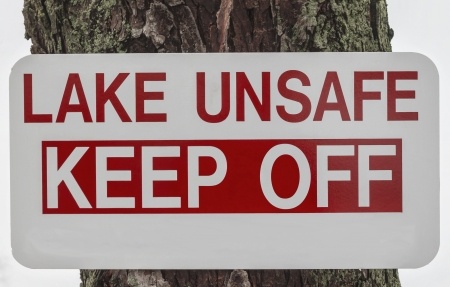

Frozen Lake Safety Tips
A frozen lake can be a great outdoor skating or hockey rink, snowmobiling surface, ice fishing spot or just a beautiful place for a walk. It is really important to understand, however, that there is no way to know for sure that the lake is frozen enough all the way around. A snow dusting on top of the ice can add to the illusion that the lake has frozen deeply. Most people evaluate the safety of frozen ice by gauging ice thickness, the daily temperature, water depth under the ice, and snow cover. The safety of frozen ice is also dependent on water depth under the ice, the size of the water and water chemistry, currents, and distribution of the load on the ice.
Frozen Lake Safety Tips
- Avoid traveling on a frozen lake early or late in the season as the ice is more likely to be thin.
- Drive or ride slowly so that you don’t get “ahead of your headlights” and fall through a hole before you even see it.
- Never travel on a frozen lake in the dark, in a snow storm, or while you are impaired as you are more likely to miss an open spot on the lake or crash into an obstacle.
- Do not walk out onto a frozen lake unless there is at least four inches of clear, solid ice; this will provide a margin of safety in case the ice is slightly thinner in other parts.
- Do not ride a snowmobile or ATV onto a frozen lake unless there are at least five inches of clear, solid ice.
- Do not ride a car or light truck onto a frozen lake unless there are at least 8-12 inches of clear, solid ice. Also, do not linger in one spot as it weakens the ice; do not park near cracks, and watch out for pressure ridges or ice heaves. It is really not advisable to ride in a vehicle on a frozen lake due to its weight.
- Always go out on the ice with a buddy and let others know where you will be in case of an accident.
- Leave a safe distance between you and your buddy while walking out onto the ice. This can help to avoid ice cracking under the weight of two people and also allows for your buddy to help you if you fall through the ice.
- Contact a local resort or bait shop for their assessment of the safety of the frozen lake and areas to avoid.
- Wear a life vest while walking or riding on a frozen lake; it can help you float if you fall through the ice and provide insulation from the cold. Exception: do not wear a life vest if you are inside an enclosed vehicle as they can make escape from the vehicle more difficult.
- Carry useful tools with you such as homemade ice picks or a pair of wooden handled screwdrivers tied together with a few yards of strong cord that can be used to pull yourself up and onto the ice if you fall in. (The wood handles will make the screwdrivers float).
If you or a loved one were injured in an accident, you have enough to deal with. Let an experienced accident attorney fight for the full compensation that you deserve. It is not uncommon to receive a settlement from the insurance company that is five to ten times bigger with the help of a lawyer. Call the caring accident attorneys at Tario & Associates, P.S. in Bellingham, WA today for a FREE consultation! We have been representing residents of Whatcom County, Skagit County, Island County and Snohomish County since 1979. You will pay nothing up front and no attorney fees at all unless we recover damages for you!




